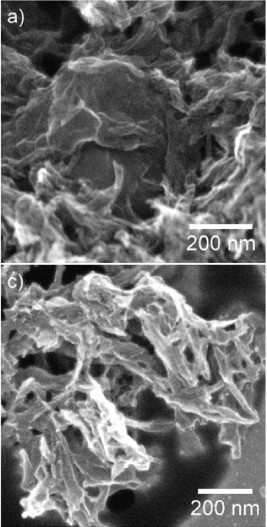Dec
13
Non Metal Electro Catalysts for Fuel Cells Invented
December 13, 2017 | 5 Comments
In a study published in the Journal of Power Sources, the team from Surrey worked with colleagues from Queen Mary University of London to create low-cost carbon based electro-catalysts for anion exchange membrane fuel cells. The catalyst helped to achieve a power density performance of 703 watts per square centimetre squared (mW cm-2) from the fuel cells – this compares to a performance of just 50 mW cm-2 from previous studies in this area.

STEM images of (a.) GU flaky N-doped carbonaceous materials and (c.) FU rod-like N-doped carbonaceous material under the scanning electron mode. Image Credit: University of Surrey. Click image for the largest view.
The catalysts were made by using a cheap clay material called Halloysite as the template, urea as the nitrogen source and furfural (an organic chemical that can be produced from oats, wheat bran or sawdust) as the carbon source. This was then processed into a fine black powder and used as nitrogen-doped carbon electro-catalyst.
Fuel cells are currently used as a low carbon energy technology for electricity generation in transportation and stationary applications, but the use of precious-metal-based catalysts, especially platinum, makes the technology expensive and less sustainable.
Dr Qiong Cai, Senior Lecturer at the University of Surrey, said: “We are delighted with the results of our non-metal electro-catalysts, which shows what can be achieved with such low-cost carbon materials. We could only achieve this via collaborations with Prof Magdalena Titirici (Professor in Sustainable Materials Chemistry at QMUL) who provided advice in material synthesis, and Professor John Varcoe’s team (Professor of Materials Chemistry at the University of Surrey) who provided the high-performance anion-exchange membranes and ionomers and supported the test of these materials in the anion-exchange membrane fuel cells.”
“We believe that more work needs to be done, but our work demonstrates that low cost catalysts can give high performances in fuel cells and can help reduce the impact of climate change on our planet,” he added.
The project was supported by the Engineering and Physical Sciences Research Council’s SUPERGEN Hydrogen and Fuel Cell Hub.
This might be the fuel cell turning point. This group points out in the paper abstract that they went over 3000 cycles during testing. When it comes to non precious metal catalysts this is a worthwhile accomplishment. One hopes replication gets underway and industry takes notice. Good work at Surrey!
Comments
5 Comments so far


Fuel cells are currently used as a low carbon energy technology for electricity generation in transportation and stationary applications, but the use of precious-metal-based catalysts, especially platinum, makes the technology expensive and less sustainable.
This group points out in the paper abstract that they went over 3000 cycles during testing. When it comes to non precious metal catalysts this is a worthwhile accomplishment.
The project was supported by the Engineering and Physical Sciences Research Council’s SUPERGEN Hydrogen and Fuel Cell Hub.
We believe that more work needs to be done, but our work demonstrates that low cost catalysts can give high performances in fuel cells and can help reduce the impact of climate change on our planet
We believe that more work needs to be done, but our work demonstrates that low cost catalysts can give high performances in fuel cells and can help reduce the impact of climate change on our planet,